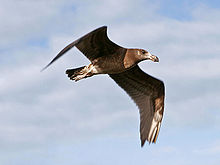Black-billed Gull
| Black-billed Gull | ||||||||||||
|---|---|---|---|---|---|---|---|---|---|---|---|---|

Black-billed Gull ( Larus pacificus ) |
||||||||||||
| Systematics | ||||||||||||
|
||||||||||||
| Scientific name | ||||||||||||
| Larus pacificus | ||||||||||||
| Latham , 1802 |
The Pacific Gull ( Larus pacificus ) is a bird art within the gulls (Larinae). It inhabits the west and south coasts of the Australian continent and Tasmania .
The kind with the extremely powerful beak has often - alone or together with the also quite dickschnäbeligen dolphin gull in its own genus - Gabianus asked. However, according to genetic findings, this has no basis and the two species are now in different genera. The black- billed gull belongs to a rather original group of four species within the genus Larus , which wear a dark tail band in all clothes and show relatively simple beak drawings and almost completely black hand wings in adult dress.
description
At 58–65 cm, the black-billed gull is about the same size as a herring gull . The wingspan is between 137 and 157 cm, the weight between 900 and 1185 g.
The head, neck and underside are white when brood. The extremely high, strong beak is yellow and has a red spot on the tip. The nostrils are more round-oval than narrow drop-shaped as in other Larus species. The iris is bright and framed by a pink-flesh-colored or yellowish orbital ring. The shoulder and back feathers are blackish; the upper wing shows a white trailing edge, but no white subterminal fields on the wings of the hand. The white tail has a wide black subterminal band . Legs and feet are yellow.
The youth dress is mostly brown, beak and eyes are dark. Immature birds are lighter on the belly and rump in comparison .
Distribution and existence
The black-billed gull colonizes the west coast of Australia from Shark Bay to the south and almost the entire south coast to the eastern border of Victoria . It is also found on the coasts of Tasmania and on many islands in the Bass Strait .
The black-billed gull population experienced a significant increase at the beginning of the 20th century and the distribution previously extended to southern Queensland . On the eastern edge of its range, however, the black-billed gull has been exposed to competition with the Dominican gull, which has been breeding in Australia since 1958, for several decades and has suffered some loss of territory there. The total population is estimated at under 10,000 pairs and the species was temporarily listed by the IUCN as “near threatened”. Today it is considered safe (“least concern”). Within its range, it is one of the most common seagulls.
Geographic variation
Two subspecies are recognized that differ only slightly.
- L. p. georgi King , 1826 - west and south coast of Australia to Kangaroo Island
- L. p. pacificus Latham , 1802 - Coasts of Tasmania and Victoria
hikes
The black-billed gull is largely a resident bird , but young birds often pass up to 20 km. The migratory movements are mostly directed northwards and extend slightly beyond the breeding area. The species occurs as a stray visitor in central and northern Australia.
Way of life
The black-billed gull is a coastal bird that rarely occurs inland. The breeding colonies are almost always on elevated islands off the coast. In the southeast of its range, the species sometimes breeds on headlands.
The food is usually looked for walking or wading on beaches or in the intertidal zone, sometimes the species can be observed while diving. Mussels and snails are opened by the seagull dropping them onto hard surfaces from a great height. The food spectrum mainly includes fish , molluscs , echinoderms and crabs . In addition, there is fishing waste, carrion and other waste. Some gastropods such as Turbo undulatus are also eaten. Sometimes bird eggs and juvenile birds, and more rarely adult birds such as the frigate petrel, are captured.
The breeding season is between September and January. Most colonies are small and have a low nest density with a nest distance of a few meters. But there are also colonies with 400 pairs. The nest is a stable structure made of grass and seaweed, which is built on rocks, in the grass or in the shell sand. The clutch consists of 1–3, but mostly 3 eggs, which are incubated between 23 and 26 days.
literature
- Josep del Hoyo , Andrew Elliott, Jordi Sargatal (eds.): Handbook of the Birds of the World. Volume 3: Hoatzin to Auks. Lynx Edicions 1996, ISBN 978-84-87334-20-7 , p. 601.
- Gerald S. Tuck, Hermann Heinzel : The sea birds of the world. Paul Parey Publishing House, Hamburg / Berlin 1980, ISBN 3-490-07818-7 .
Web links
- Larus pacificus in the endangered Red List species the IUCN 2009. Posted by: BirdLife International, 2008. Accessed July 8 2011th
- BirdLife International: Species Factsheet - Pacific Gull ( Larus pacificus ) . Retrieved July 8, 2011.
- Videos, photos and sound recordings of Larus pacificus in the Internet Bird Collection

